Looking for a treat for your garden? Try planting candytufts! These delightful plants produce abundant flowers with an appearance as sweet as their name.
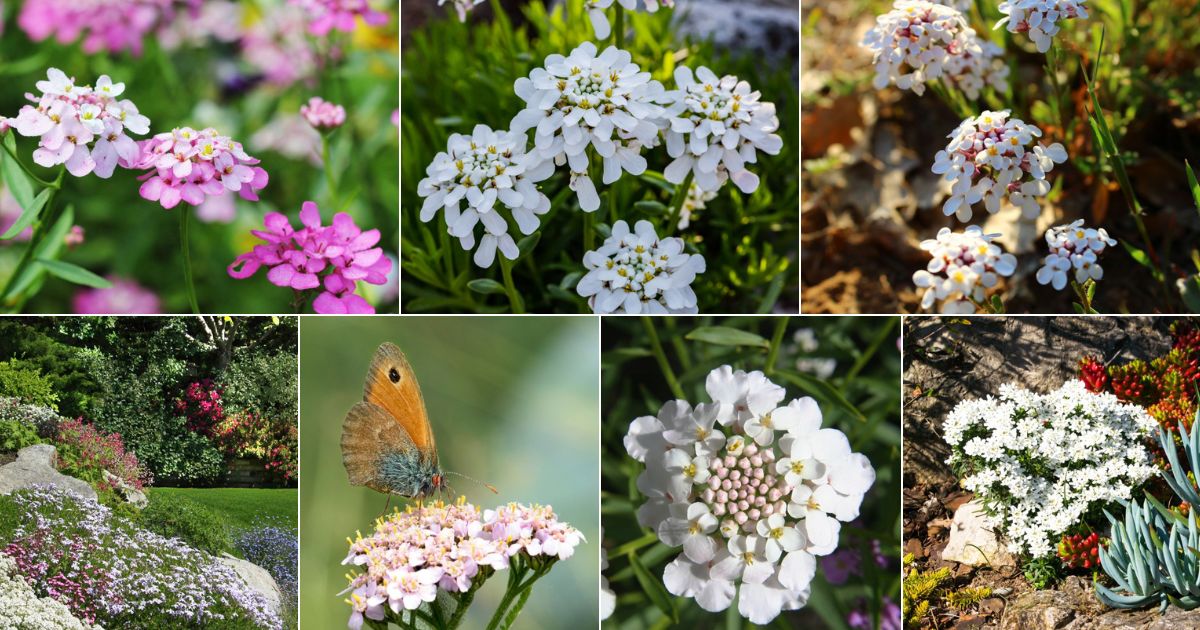
In this guide, we will teach you where you can grow candytufts, what conditions they need to thrive, when they bloom, and how to plant and care for them.
You can use the table of contents below to jump directly to the section you are interested in, or you can scroll down to read the full candytuft growing guide.
Jump to:
- What Are Candytufts?
- Candytuft Basics
- Where Do Candytufts Grow?
- Why Grow Candytufts?
- Candytuft Landscaping Ideas
- Recommended Candytuft Varieties
- When Do Candytufts Bloom?
- How Long Do Candytufts Bloom?
- When to Plant Candytufts
- Ideal Growing Conditions for Candytufts
- How to Plant Candytufts
- How to Care for Candytufts
- How to Divide and Transplant Candytufts
- Recommended Companion Plants for Candytufts
- Frequently Asked Questions About Growing Candytufts
- Where to Buy Candytufts
What Are Candytufts?
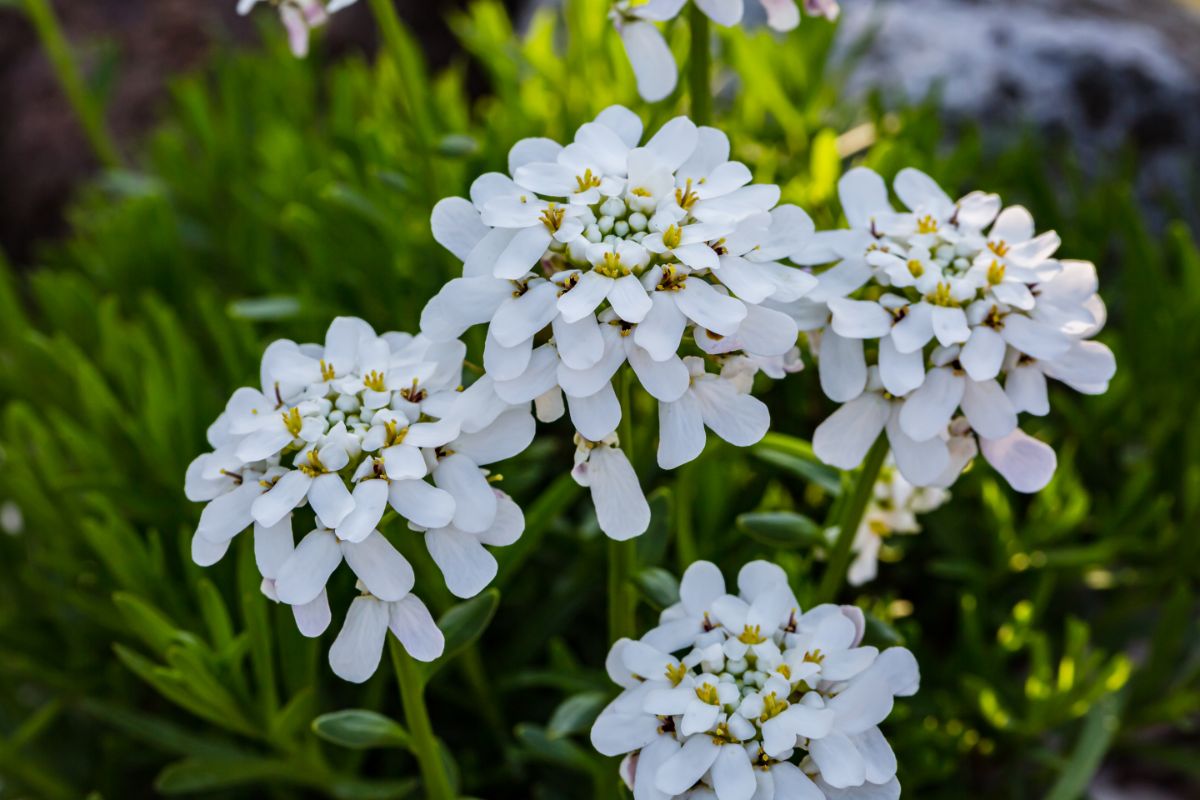
Candytuft is the common name for the genus of plants with the scientific name Iberis. Though they produce lovely ornamental blooms, they actually belong to the same family as cabbages, Brassicaceae.
You might think that the name of the plants has something to do with sweet confections. But actually, it is a reference to Candia, which was once the name of the capital of Crete, today known as Iraklion.
The University of Arkansas System says, “Iberis sempervirens is considered the most garden-worthy of the 45 species of candytufts that are widely distributed throughout southern Europe, North Africa and the Mediterranean region.”
Curious about the origin of the name “Iberis?” The first usage was by Linnaeus in the 18th century. It is a reference to the Iberian Peninsula in Spain.
Candytuft is usually a perennial plant, which means that it blossoms year after year. If you plant it in your garden and take good care of it, you can enjoy it for a long time to come.
The plant is also classified as an evergreen—but exactly what that means depends on where you live. The Missouri Botanical Garden says, “It is evergreen in warm winter climates, but semi-evergreen in cold winter climates where the foliage may become straggly or otherwise suffer significant decline in harsh winters.”
The flowers of the candytuft are white, lilac or pink, and form dense, attractive mounds.
Candytuft Basics
Zones: 3-9
Blooming season: Spring through summer
Expected height: 6-8 inches
Soil: Well-drained, sandy, alkaline
Sun: Full sun
Where Do Candytufts Grow?
Candytufts originally come from Europe, but now are cultivated around the world. Growing in zones 3 through 9, they can thrive in a range of climate conditions.
Why Grow Candytufts?
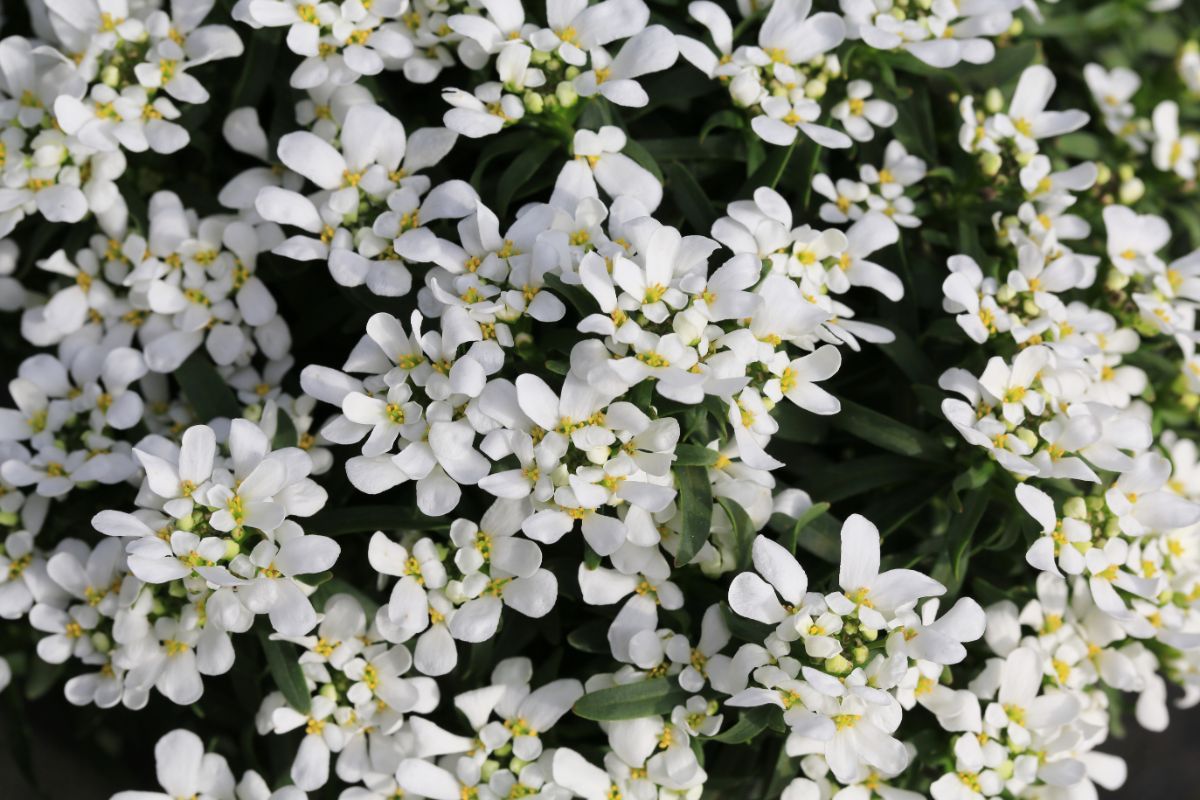
- As evergreens, these plants will continue to bring color and beauty to your garden through all four seasons.
- This is a drought-resistant plant that can flourish in relatively dry environments.
- Are there a lot of deer or rabbits where you live? You will be thrilled to learn that candytufts are considered a rabbit- and deer-resistant plant.
- There are numerous landscaping ideas for candytufts, as you will discover in the next section.
- It is possible to use candytufts in your bouquets and arrangements, even though not a lot of people think to do so.
- The bloom time for candytufts is typically delightfully long. That means they can fill out empty areas in your garden through most of the season.
- Candytuft is a perennial that is really easy to grow! Even if you are a novice gardener, you will likely be able to get them to flourish without a lot of care or attention.
- Want to bring some friendly visitors to your garden? Bees and butterflies may both home in on candytufts. These pollinators are fun to watch and beneficial to your garden ecosystem.
Candytuft Landscaping Ideas
One of the most exciting things about candytufts is how versatile they can be in your garden.
- Rock gardens. Candytufts can grow well in sandy or rocky soils. For that reason, they are a popular addition to rock gardens.
- Groundcover. The low, spreading habit of candytufts makes them ideal for groundcover.
- Borders. You can line walkways and driveways with borders of candytufts. They look beautiful on their own, or alternating with another plant.
- Retaining walls. Candytuft varieties can make excellent perennials for your retaining walls.
- Fill in gaps. With their profusion of blooms, candytufts have a full, voluminous appearance, making them ideal for filling out gaps in your garden.
- Containers. Candytufts can easily thrive in containers. So, think about planting some to bring some beauty to your patio or deck.
- Victorian gardens; In the US, candytufts may be associated with the Victorian era, which was right around when they were first marketed heavily in that part of the world. As a result, they may be just the blooms you need to capture the idea of a Victorian garden today.
Recommended Candytuft Varieties
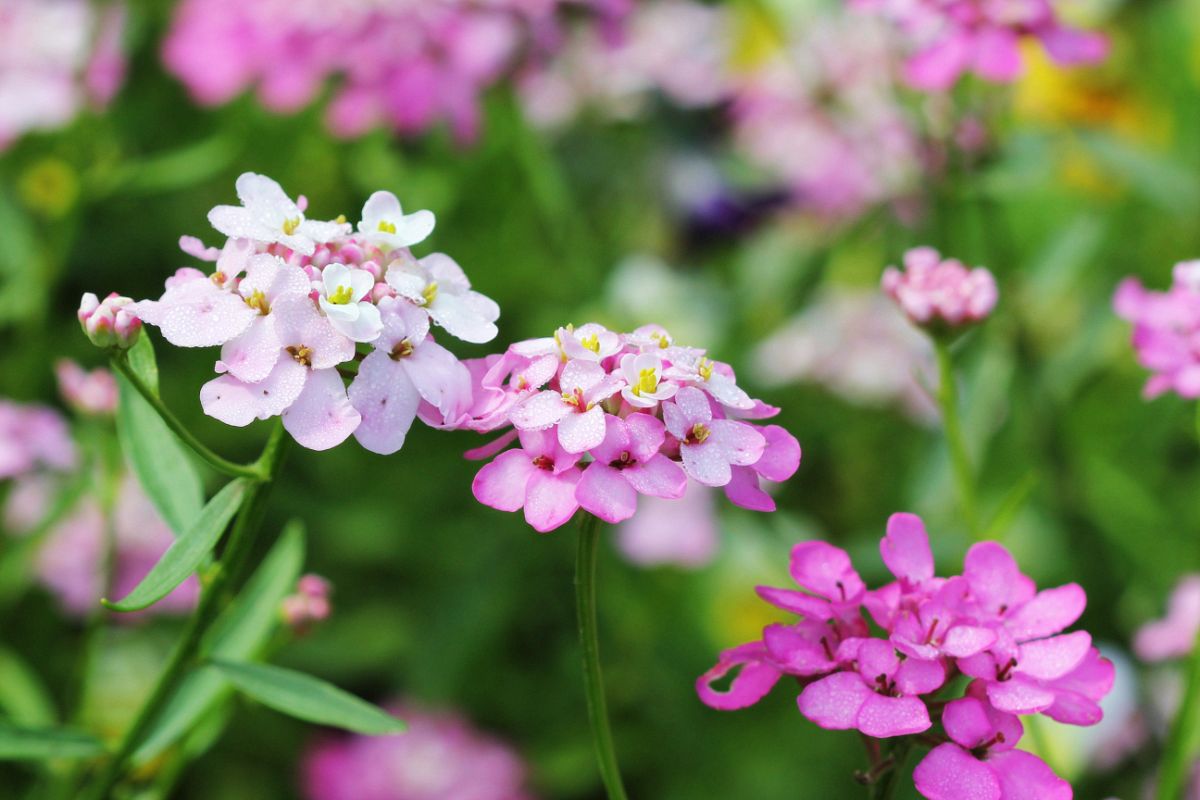
There are quite a few different cultivars of candytuft you can add to your garden beds. Here are a few to think about:
- Little Gem: If you are in search of a compact candytuft cultivar, this variety that produces white flowers can work well in containers or borders. Its height maxes out at around 6-8 inches.
- Alexander White: This popular cultivar of candytuft flowers blossoms in spring and summer. The flowers are white, but if you look closely, you will see that their centers are greenish.
- Whiteout: Is Little Gem not compact enough for you? If you want a variety of candytuft that is really short, you can purchase Whiteout. This variety maxes out at just 3 inches tall.
- Tahoe: Like many other types of candytuft, the Tahoe cultivar produces white flowers, and reaches around 8-10 inches tall. While you will enjoy these attractive flowers when they blossom, you may do so with a hint of melancholy as they are quite ephemeral. By the time summer rolls around, Tahoe is all done blossoming.
- Masterpiece: Are you looking for a variety of candytufts that features bigger-than-average blossoms? The beautiful flowers of the Masterpiece variety will impress you, as will its lengthy bloom time. The white flowers start blossoming in spring and can continue into the early part of autumn. One more detail you will enjoy is the faint pinkish color you can just make out in the middles of the blooms.
- Snowflake: Snowflake candytuft flowers are another lovely choice if you want profuse bright blossoms in white.
- Autumn Snow: If you want autumn flowers, one candytuft variety you may want to think about planting is this one, named for the flush of blooms it tends to produce when fall sets in.
- Pink Ice: Most varieties of candytufts are white, but there are some dazzling exceptions. One of them is this cultivar that produces pink flowers. The petals are light pink and the middles are a slightly darker pink.
- Purple Rain: These candytuft plants produce flowers with a striking purple hue.
These are not the only cultivars of candytufts. If you cannot find the large selection you are looking for at your local garden center, you can locate additional varieties online.
When Do Candytufts Bloom?
You will see abundant blooms opening on your candytufts starting in spring. The flowers will continue into the summer. By the end of summer, most candytuft varieties have finished their bloom season. But there are a few cultivars that produce a second flush of blossoms early in autumn.
How Long Do Candytufts Bloom?
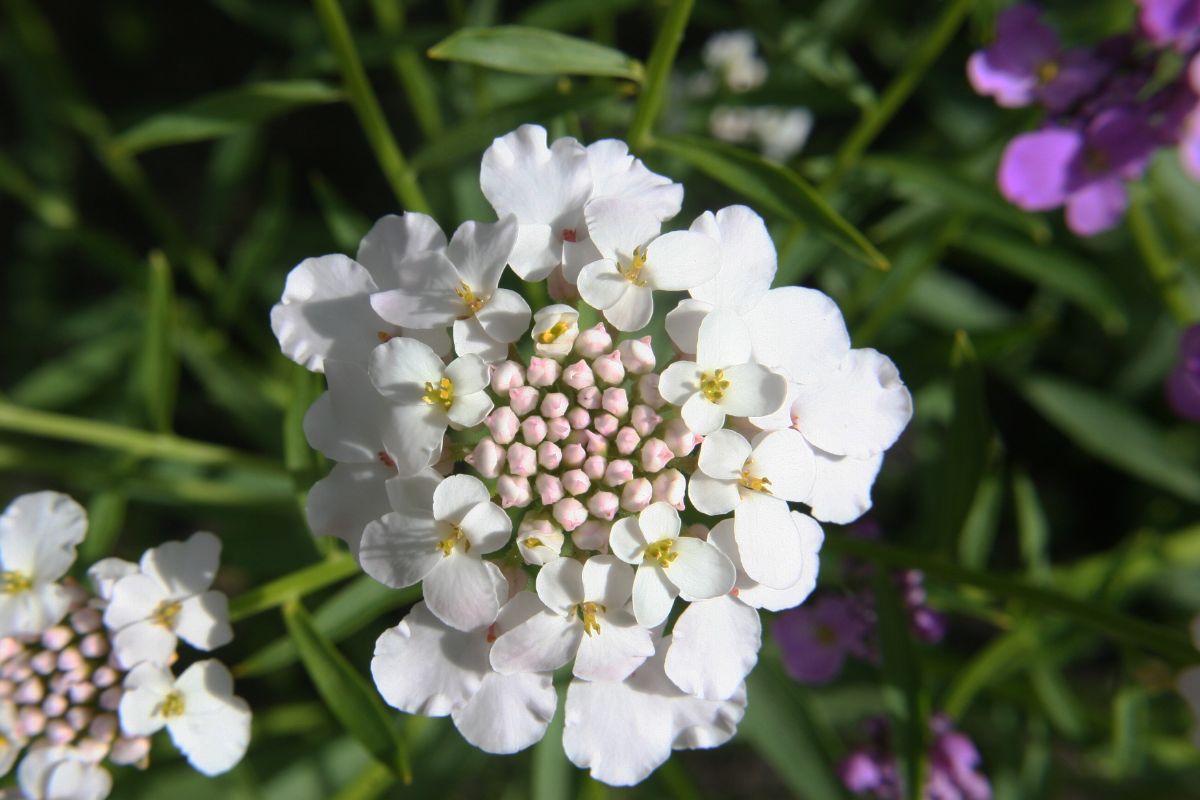
The bloom time for a candytuft plant can last for months as repeated flushes of blossoms are possible with proper care.
But there are some cultivars that do not blossom past spring. So, check to see the specific bloom period for a variety before you buy it.
When to Plant Candytufts
When planting candytufts, it is ideal to do so early in autumn. But the middle of April is also an option.
Ideal Growing Conditions for Candytufts
Growing candytuft flowers successfully starts with planting them in the right conditions. Below, we talk about sun, soil and water requirements for these perennials.
How Much Sun Do Candytufts Need?
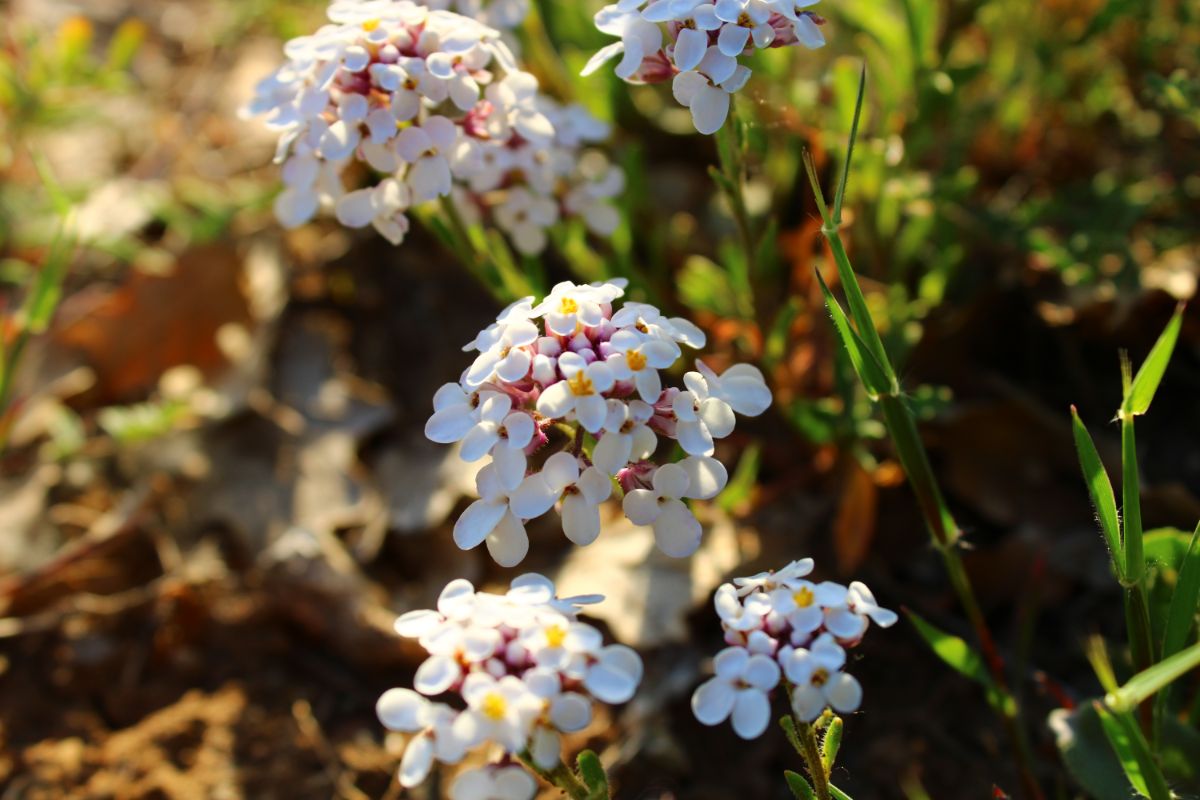
Candytufts do not like shade. You should always plant them in full sun. They need a minimum of six hours of direct sunlight per day.
What Type of Soil is Right for Candytufts?
We have talked about sunlight, but what about soil considerations? Sandy or gravelly soil is ideal for candytuft plants. But they also can grow in loam or clay soils.
You will get the best results when you plant candytufts in soils that are alkaline. You can get away with neutral soil or even mildly acidic soil. But if your soil is very acidic, you should consider adding lime to it before you plant these perennials in order to adjust the pH.
Although you should keep the soil moist, it is important that you use only well-draining soil.
Whatever you do, do not allow the soil to be soggy. Just as shade is really bad for these plants, the same is true with too much moisture.
How Much Water Do Candytufts Need?
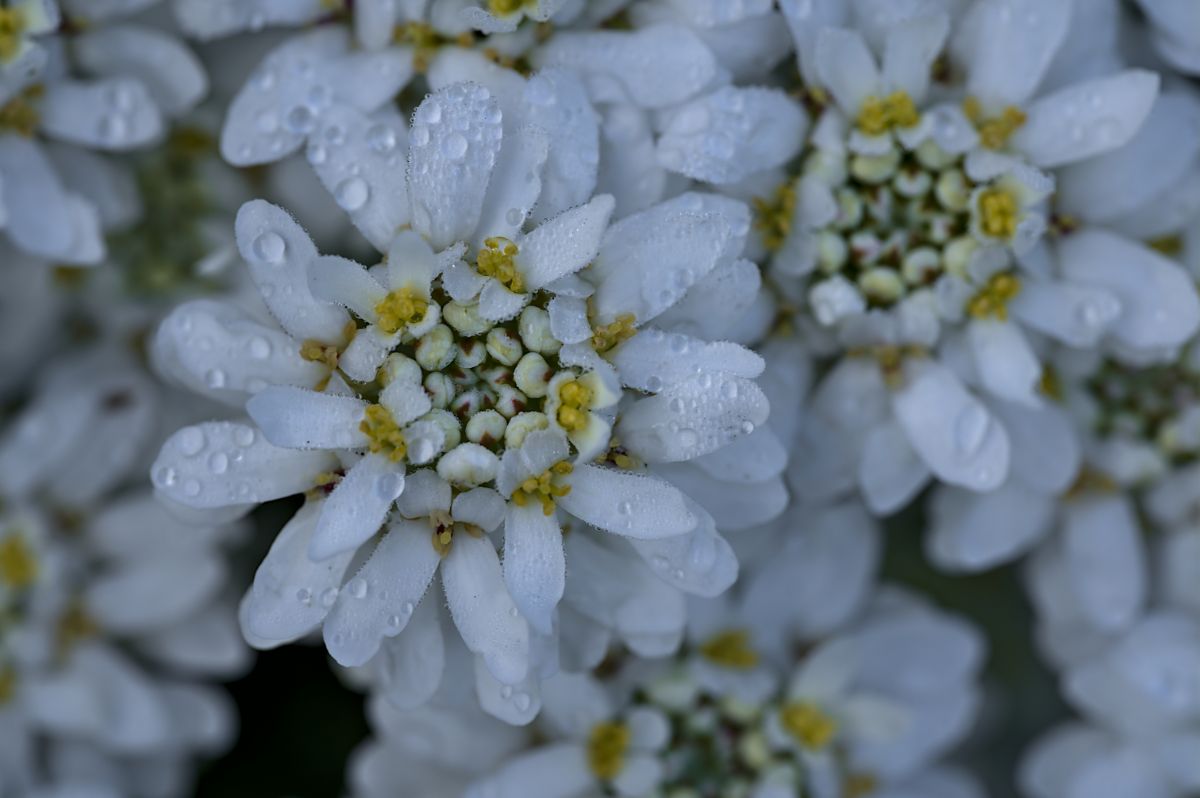
While frequent watering is necessary when your candytuft is establishing, afterwards, you can reduce the schedule to weekly waterings.
How to Plant Candytufts
You now know what conditions you need for your candytufts, so it is time to plant them! Usually, you will start with a nursery plant. But in some cases, you might also grow these flowers from cuttings or seeds.
We will go over directions for each of these below. For the sections on Container Planting and Ground Planting, we are assuming that you are starting with a nursery plant.
Container Planting
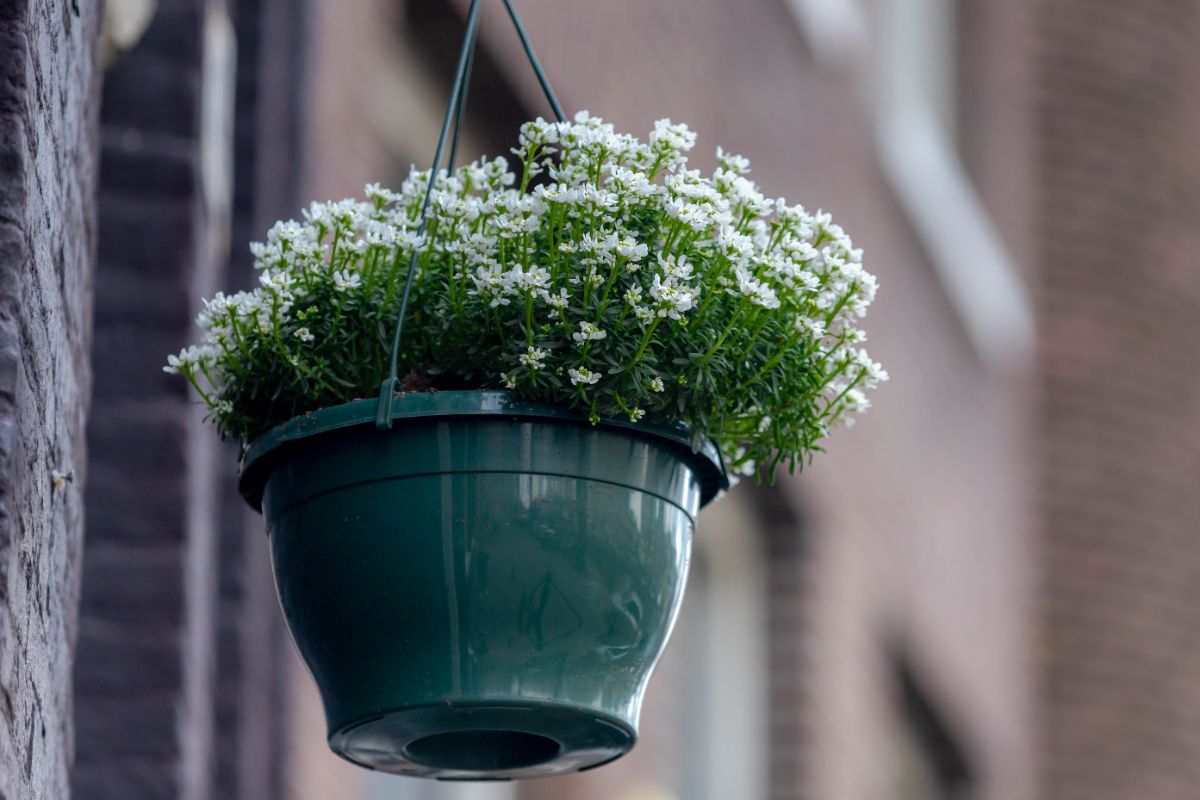
- Before you can grow candytufts as container-grown plants, you need to choose a suitable flower pot. Check for drainage holes, and insert them if you do not find them.
- Fill the container with appropriate well-draining soil.
- Make holes for your candytufts and plant them.
- Backfill the soil and water well.
As your candytufts establish, water them twice weekly. Once they are established, you can switch to a long-term watering schedule of once a week.
During the hot days of summer, keep an eye on your potted candytufts. They might need a little more water than those in your garden beds, since soil in containers dries out more rapidly.
Ground Planting
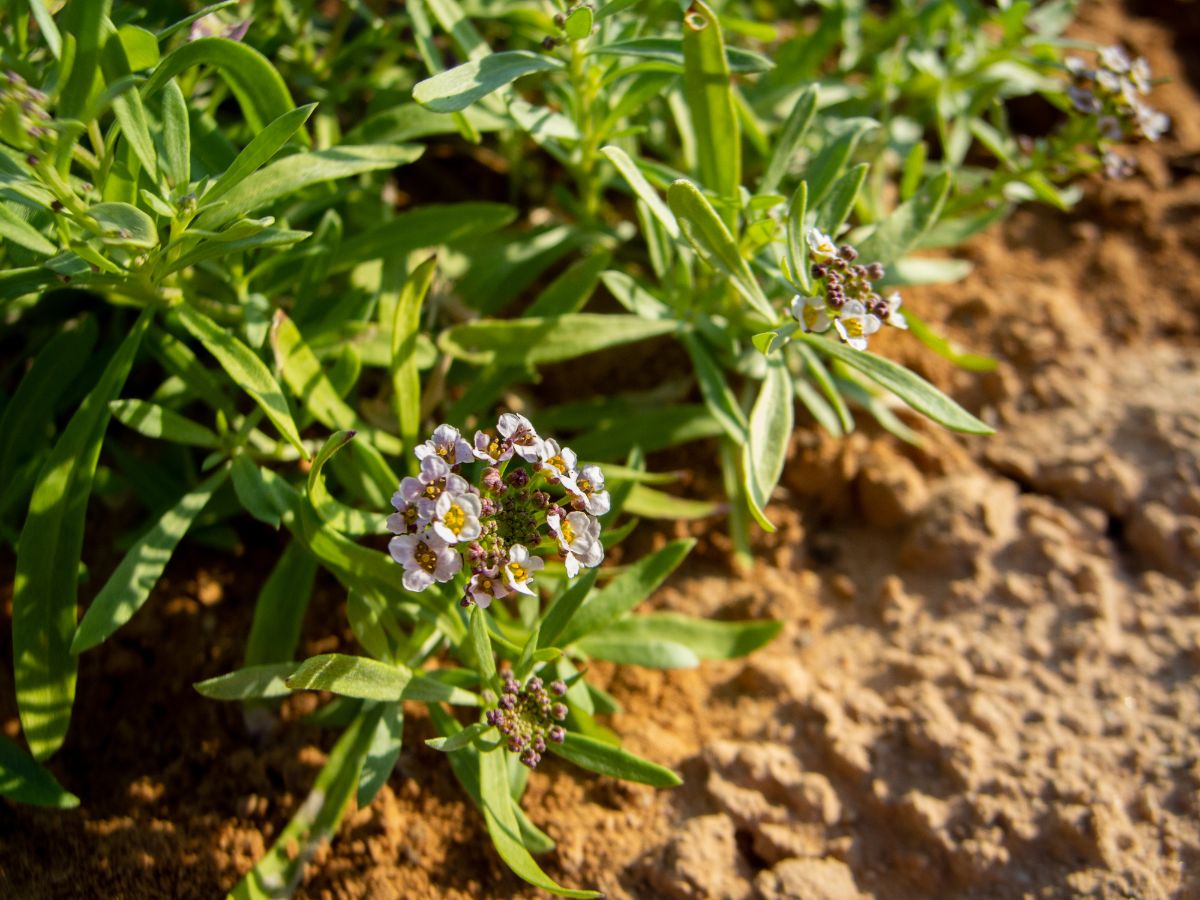
Here are the steps for transplanting candytuft nursery plants directly in your garden beds.
- Choose the right spot in your garden. That means an area which receives ample sunlight. In most situations, shade is not advised. But if your climate is really hot during summertime, it might be appropriate in the afternoon.
Put plenty of thought into picking the location for your candytufts. You want to avoid having to move them in the future.
- Get the soil ready. Remember, you might need to adjust the pH with some lime.
It is also important that the soil drain effectively. If it does not, you can add sand or compost. This may make it suitable for your candytufts.
- Dig holes in your soil and plant the candytufts. You should put about 6 to 12 inches of space between them.
Too much moisture is very bad for these plants! So you must not crowd them together. Be sure that they also will be far enough away from other types of plants that the air can circulate.
- Backfill the soil and water well.
Remember to give the candytufts extra water while they are establishing.
Starting Candytufts from Seeds
If you want to start candytufts from seeds instead of using nursery plants, you can follow these steps. Get started 6-8 weeks before you expect the last frost.
- Pick containers to use. Seed starting trays are ideal. Check to make sure that they are able to drain. You can add holes if necessary.
- Put seed starting mix in your container. Leave around ½ inch at the top.
- Moisten the soil. You want to do this step before you sow the seeds. After the soil is moist, let it drain and tamp it down.
- Sow the candytuft seeds. This is as simple as sprinkling them on top and then putting a bit of soil on top of them. Around ⅛” is good.
- Use a spray bottle to get the top of the soil damp again if necessary. Do not pour water in directly, or you will wash out the seeds.
- Use plastic wrap or a cover to lock moisture into the container.
- Pick a suitable location for germination to take place. 65-70 degrees Fahrenheit is ideal. If necessary, you can use a heating mat.
- Wait for the seeds to germinate. Periodically, you will need to use the water bottle to dampen the soil again. You should see the seeds sprouting in around 16-20 days.
- Take off the plastic wrap, and make sure your seedlings are getting sunlight to grow.
- After the last frost is passed and the seedlings are big enough, you can harden them. You need to bring them outdoors, then back in, then out, then in, until they are used to being outside.
- Transplant them seedlings into your outdoor containers or garden beds.
It is worth noting that transplanting candytufts successfully is not always easy. For that reason, you might actually want to think about starting the seeds outdoors. Either way, be careful with the young plants.
Starting Candytufts from Cuttings
Another method you can use to propagate candytuft is to take cuttings. Here are the steps.
- Cut a stem to use. It should be green.
- Dip the cut end of the stem in rooting hormone.
- Fill a container with an appropriate mix (as always, the container needs to have drainage holes).
- Poke a little hole, and insert the cut end of the stem.
- Use a spray bottle to make the soil moist. Then, cover the container, making sure the stem has enough room.
- Regularly check on the cutting and moisten the soil as needed.
- Eventually, the cutting will root. After it does, give it a little more time to establish and grow.
- Harden the new plant when it is ready.
- After hardening, you can transplant the new plant outdoors.
How to Care for Candytufts
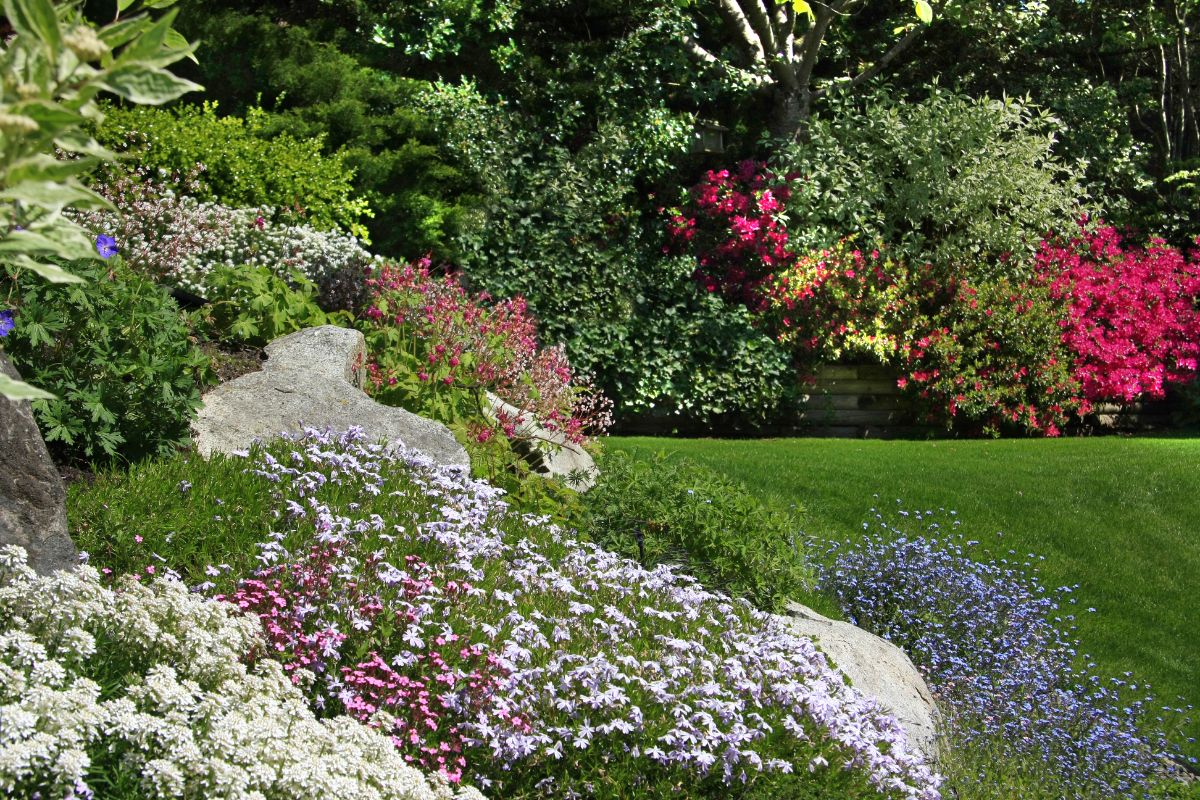
We have talked about how to get your candytuft plants started. But once you do, you need to keep taking good care of them so that they will keep thriving over the years to come. Let’s talk about fertilizing mulching, and more.
How to Fertilize Candytufts
Candytufts can benefit from fertilizer that contains a high amount of phosphorus and a low amount of nitrogen. Add it to the soil in spring, and go with a slow release formula.
How to Mulch Candytufts
If you live in a colder climate, you may need to take the extra step of mulching your candytuft plants in preparation for winter. Doing so will provide the plant’s roots with some much-needed insulation.
How to Stake Candytufts
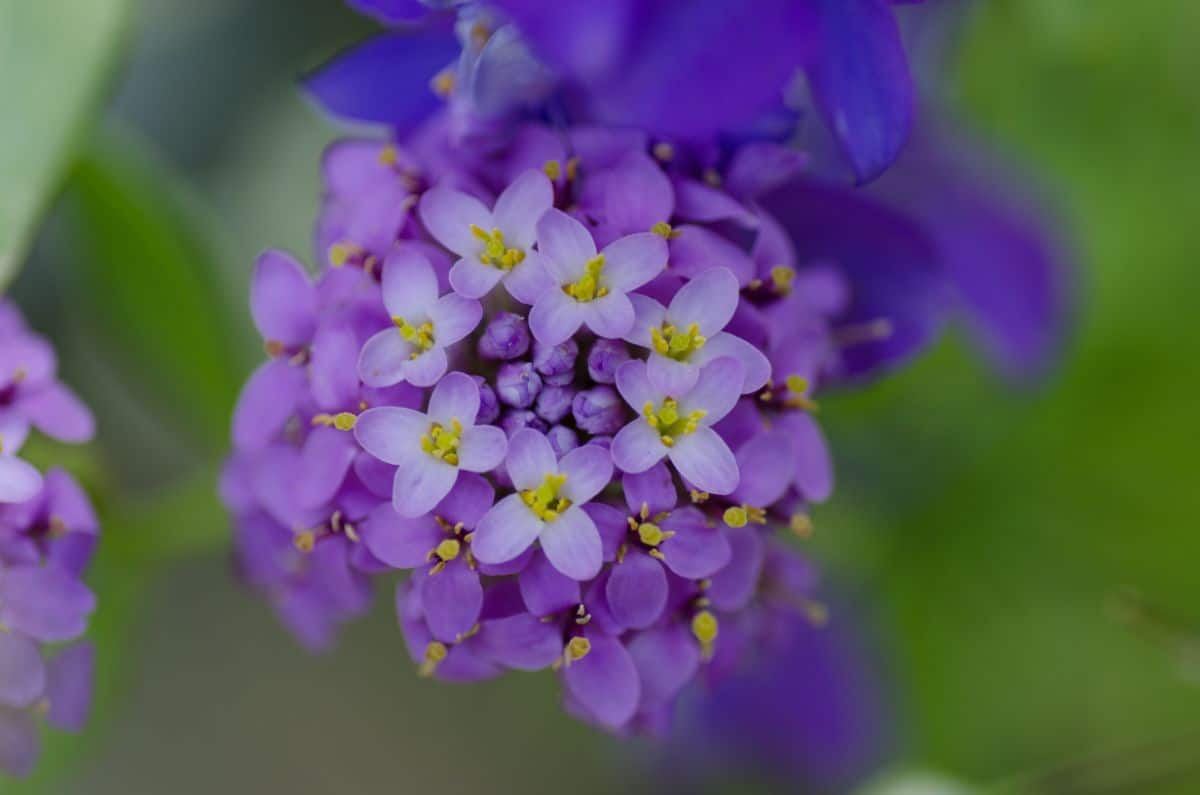
You guessed it—candytuft is a plant you do not need to stake. It grows very low to the ground, so there are no long stems you need to prop up. And if you plant it on a retaining wall, you actually want it to spill over.
How to Prune Candytufts
Pruning your candytufts involves a combination of cutting and deadheading. Let’s discuss both.
How to Deadhead Candytufts
When the flowers on your candytuft plants start to wilt, it is time to deadhead them. Removing the spent blooms will give the plant a chance to flower again, providing you with a longer bloom season.
When to Cut Back Candytufts
You should cut back your candytufts after they are done blossoming. Hard pruning is also appropriate if your plant has become leggy.
Pro Tip: You should avoid pruning your candytufts if you planted them on your retaining wall. Why? The leggy quality you want to avoid in other locations in your garden will actually help them to grow the way you want over the wall.
Are Candytufts Vulnerable to Diseases or Pests?
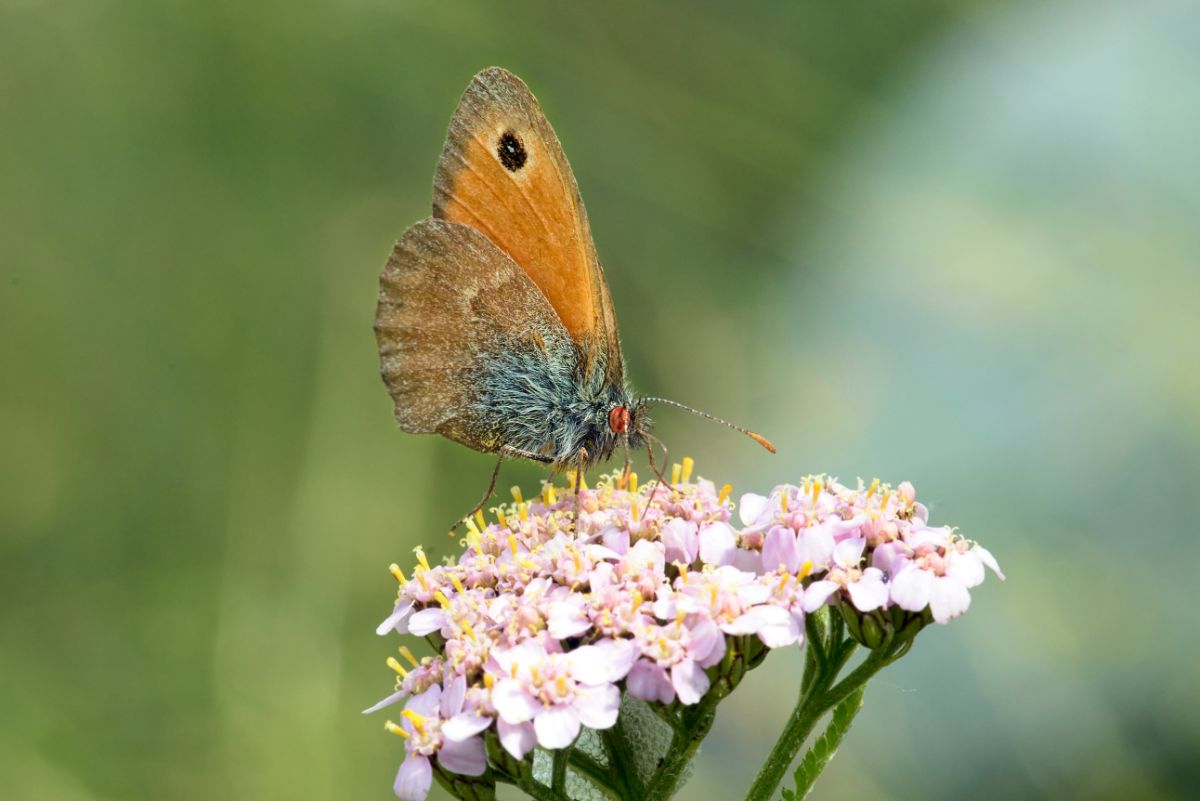
Diseases to watch out for on candytuft plants include bacterial leaf spots, powdery mildew, crown rot, root rot, fungal leaf spots, downy mildew and botrytis.
How can you prevent these problems? Clemson Cooperative Extension says, “All of these pathogens are typically encouraged by excess moisture on the leaves (usually after frequent rain or overhead irrigation), so cultural practices, such as proper spacing to encourage air movement, removal of dead plant material, and utilizing drip irrigation instead of sprinkler irrigation, will reduce the risk for infection.”
It is unlikely that you will need to worry much about warding off insects. But sometimes aphids attack these plants. You also may have issues with caterpillars, slugs, or snails. Clemson Cooperative Extension advises, “There are several naturally occurring predators for aphid control, such as green lacewing larvae, ladybird beetles (adults and larvae), and parasitic wasps. If an insecticide is necessary for control, use a spray of horticultural summer oil or insecticidal soap.”
Thankfully, you should not need to concern yourself about mammals as pests. Deer and rabbits tend to avoid candytufts. They do not seem to like how these flowers smell.
In fact, that means you might want to consider planting them near flowers that the deer and rabbits do like to harass. They could serve as a mild deterrent.
How to Divide and Transplant Candytufts
As we mentioned, candytuft is a plant that does not usually take all that kindly to being relocated. Nonetheless, you may want to occasionally divide candytufts. When you do, you can follow these instructions in spring or autumn.
- The day before you intend to transplant the candytuft, water it deeply. Avoid transplanting on days that are especially hot or bright.
- Get a shovel and dig around the plant. Make sure you are at least 8 inches out so you do not damage the roots. Once you have made a circle around the candytuft, you can dig underneath the roots and push upward to lift it up out of the ground.
- Cut the roots to separate the candytuft into several smaller plants.
- Dig holes for the new plants and insert them into the soil. Backfill the soil and water the candytufts deeply. Resist the urge to tamp the soil down to hard. It needs to drain.
- Water the plants extra as they establish, and ten switch back to a regular watering schedule.
Recommended Companion Plants for Candytufts
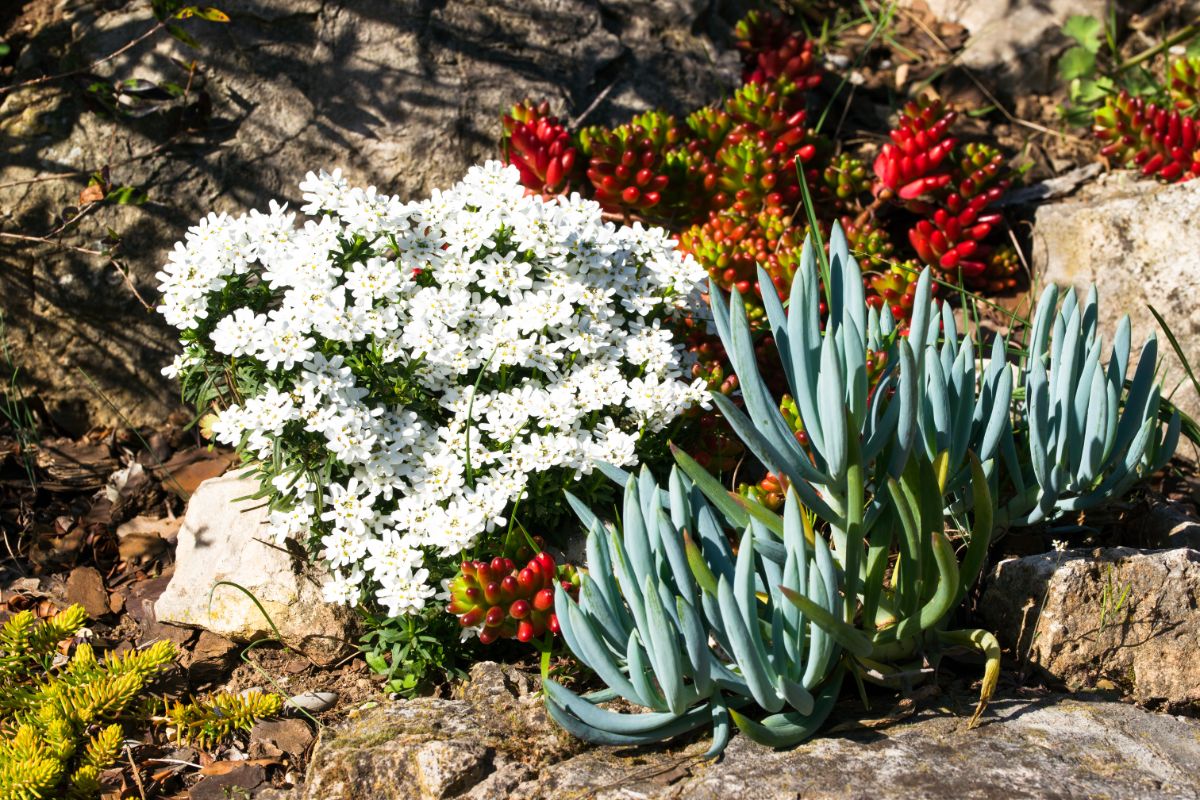
When you are figuring out where you want to put candytufts in your garden, it is the right time to start thinking about the possibilities for companion planting. Here are just a few ideas to consider.
- Perfume Lilac: This type of lilac loves sunlight just as much as candytufts, and makes an ideal companion. Choose a cultivar of candytuft featuring purplish blossoms for complementary colors, or go with a snow white candytuft variety for more of a contrast.
- Tulips: These classic spring-blooming flowers can be a graceful accompaniment to your candytufts.
- Stonecrop: Just as the name would have you guess, stonecrop is a flower that thrives in rocky conditions. The flowers are generally pink or yellow, and the foliage is striking. Plant them in your rock gardens interspersed with candytufts.
- Phlox: This creeping flower blossoms in spring and summer just as candytuft does. You could consider alternating between the two for a dramatic effect.
There are numerous other companion planting ideas for candytufts, so hunt around for more before you plant yours.
Frequently Asked Questions About Growing Candytufts
To wrap it up, here are answers to a couple of frequently asked questions about candytuft plants.
Q: What eats candytufts?
A: If something is chewing on your candytufts, it is not likely to be a mammal. It is probably aphids, caterpillars, slugs or snails.
Q: Are candytufts annual or perennial?
A: You can find examples of both annual and perennial types of candytufts. Nevertheless, most of the time, when we talk about candytufts in the USA, we are referring to perennial varieties. If you are in Europe, however, someone mentioning candytufts may very well be referencing an annual type.
Q: Is candytuft poisonous to dogs or cats?
A: We have seen some mixed claims about whether or not candytuft is toxic to pets. But Gardener’s World reports that it isn’t. Since this is a reputable source, we think that is should be fine to plant in your yard if you have pets.
Where to Buy Candytufts
The dense mounds of flowers candytuft plants produce can have a wondrous effect lining a path, spilling over a retaining wall, or blossoming in your rock garden.
If you are ready to bring the splendor of these bright flowers to your own garden, click below to shop candytufts online now.


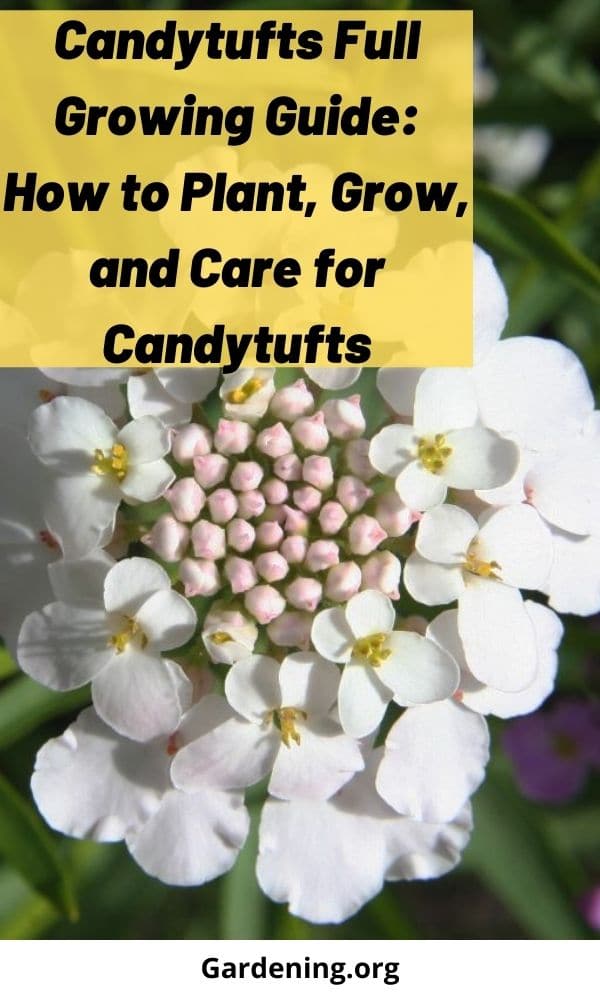
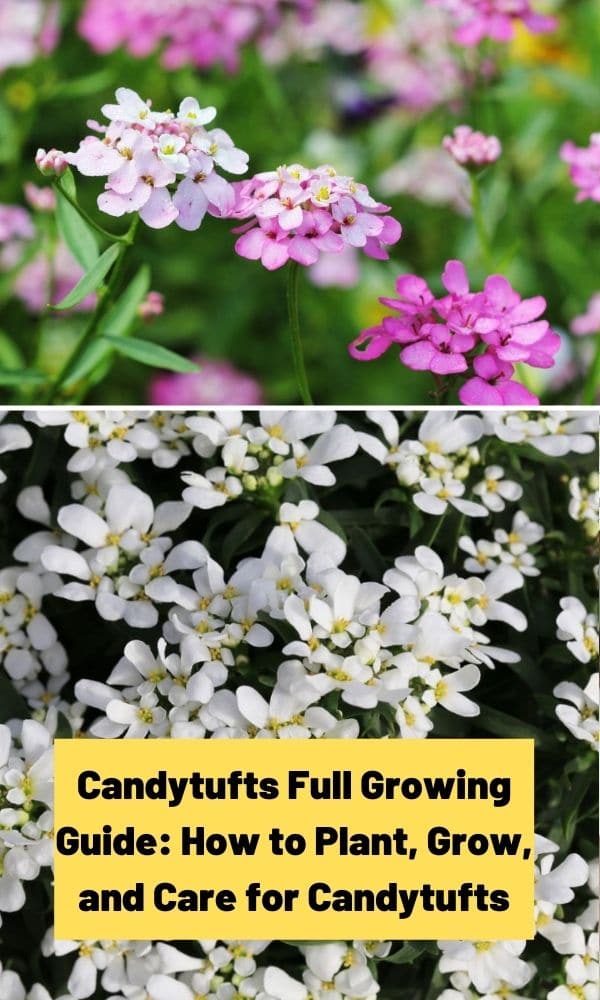






Diane Werning
Those flowers were very pretty,do you have any ideas for a balcony? I have two large ones I want to fill with flowers.
Mary Ward
Any container garden flowers, patio garden, or window box recommendations would work very well. There are even some attractive edible you can grow in containers, too. We have a lot of articles for each of these here on the site. Check out some of the "Thrillers and Spillers" posts.